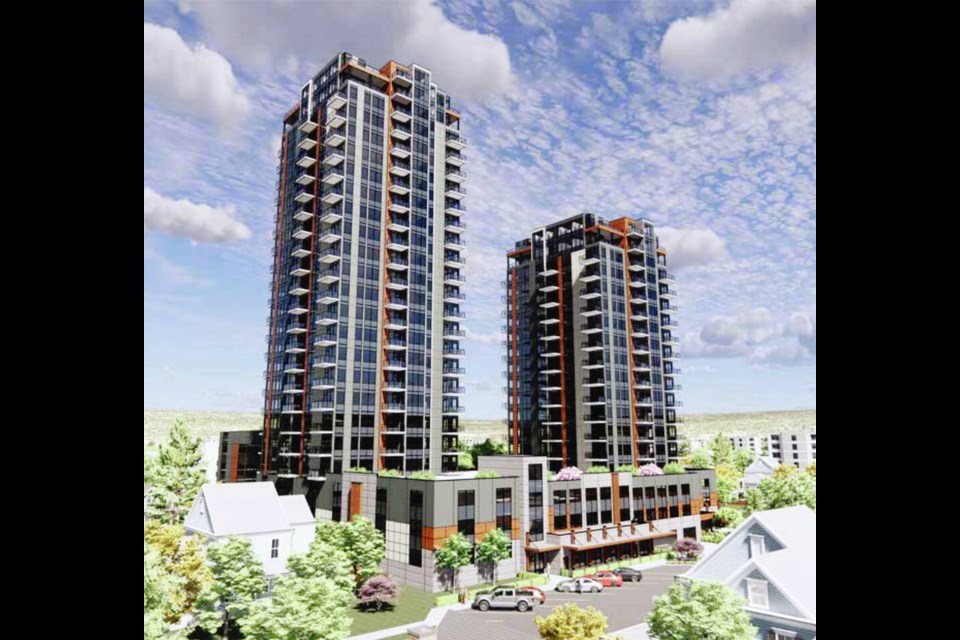Langford, B.C., council has approved zoning changes to allow four condominium buildings of up to 24 storeys in neighbourhoods of aging single-family homes, as the Greater Victoria suburban city starts a “transition” to bring density to its core.
Mayor Stew Young said the only place left in Langford to provide affordable home ownership and “vitality to our core” is through height and density, as outlined in the official community plan.
The zoning changes received plenty of public support, but there was criticism, including concerns about heights from Coun. Denise Blackwell, whose comments before the vote sparked a sharp exchange with the mayor.
Blackwell, chair of Langford’s planning and zoning committee, told the meeting she agreed with the CRD’s Regional Growth Strategy that it’s important to build “up and not out.”
“However, I never imagined we would be going over 12 storeys. I think these buildings that are higher than 12 storeys are too much,” said Blackwell. “The community is telling us they don’t like it and I agree with them.”
Blackwell said residents should have a say in how high buildings can be permitted to go, adding: “I don’t remember ever having a discussion among ourselves or at this table about how high we were going to go.”
But Young, who was noticeably angered by Blackwell’s comments, noted that Blackwell has already approved several tower proposals in the city — at Bear Mountain, Leigh Road and Westhills — and accused her of “throwing staff under the bus.”
“Just to clarify, the staff have done a great job … this has been in our [official community plan] since 2008 to have density in the core,” said Young.
Two companies have submitted rezoning applications for developments containing more than 700 condominium units, commercial and office space, and daycares.
Langford Gateway Developments Inc. is proposing to build 22- and 18-storey towers on a parcel bordered by Arncote Avenue, Peatt and Sunderland roads. The Langford Gateway project envisions 269 units and a large daycare centre in the initial two towers, and two more buildings of smaller or equal heights in a future phase with about 200 units and office space.
Less than two blocks away at Peatt and Scafe Road, Jagpal Development is planning a 24-storey tower with 269 homes, as well as 271 units in an adjacent 18-storey building, as part of its Langford Central project. The two would be connected by a four-storey parking podium with commercial space, a daycare facility and about 20,000 square feet of office space.
Coun. Lillian Szpak also expressed concern about the tower proposals’ heights and lack of “breathing space.” She said developers should invest in more land for that purpose before they proceed with projects.
Szpak, who, along with Blackwell, voted against the rezoning, suggested council take a look at one application at a time when it comes to building heights.
Young, however, said three meetings between council and architect and urban planner Avi Friedman have produced unanimous agreement that density within the core is the way forward for Langford, now reaching a population of 50,000.
“You can’t be prosperous and can’t have vitality with single-family homes in the downtown core,” said Young.
Young said Langford has to look at its long-term future. “Are we going to build six-storey buildings all over Langford or are we going to get density in the core and have vitality in the core?”
The mayor said in an interview after the meeting that the city has been talking about towers for 20 years.
Young said investors have been buying up single-family homes in the area for several years, expecting to sell when larger projects are planned. One buyer, he said, has acquired a city block of 17 1940s-era properties and is using them for rentals.
Young said density creates a city hub where people live and work, and makes home ownership more affordable — in the $300,000 to $600,000 range.
“Our biggest problem right now is a single-family home is about $900,000, and not many new homeowners can afford that,” he said.



